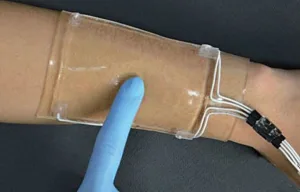One possible scenario for future human-computer interactions envisions touch panels that are stretchable. Even more visionary are concepts that utilize touch panels that are biocompatible in order to allow integration with the human body. Based on today’s technologies, achieving such functionality is difficult in as much as most touch panels use materials that do not lend themselves to stretchability. To address this issue, researchers have investigated stretchable touch panels based materials that include carbon nanotubes and metal nanowires. Unfortunately, the performance of touch panels based on these materials were found to fall off sharply when stretched. In addition, touch panels utilizing these materials were not durable.
A team of researchers in the Department of Materials Science and Engineering at Seoul National University (Seoul, South Korea) are addressing this issue. The team is developing a touch panel made of a hydrogel. This is the same type of stretchable material used to make soft contact lenses.
Recent results from the team were reported in an article entitled “Highly stretchable, transparent ionic touch panel.” It appeared in the journal: Science 12 Aug 2016: Vol. 353, Issue 6300, pp. 682-687. A copy of the article is available for purchase on-line and can be found here.
The touch panel consists of a polyacrylamide hydrogel that contains lithium chloride salts. These ionic materials are electrically conductive and help the hydrogel hold onto the water necessary for the material to stay soft.
“A surface-capacitive touch system is utilized to sense a touched position. In operation, the same small AC voltage is applied to all four corners of the touch pad. Because the signals are in phase and the hydrogel acts as a capacitor, no current flows until the device is touched. When a grounded object such as a human finger makes contact with the touch pad, it closes the circuit, and current flows from each corner in proportion to how close the finger is to that corner. Sensors then measure the difference in current that each corner of the pad receives to determine the finger’s position.”
The researchers report that the touch panel created from this material is soft and can sustain a large deformation. More specifically, it was demonstrated that it could be operated under more than 1000% areal strain without significant performance degradation. It also worked when bent around the skin of a person’s arm.
Another feature of the new touch panel is that it is quite clear having 98% transmittance for visible light.
A video illustrating the new touch panel in operation can be found at the end of this article.
In their article, the researchers noted that, after 100 stretch cycles, the performance of the touch panel slightly decreased. They suggest this is because water evaporated from the hydrogel. Addressing this drying-out process is a likely focus of future development work by the team. -Arthur Berman
Seoul National University, Jeong-Yun Sun, [email protected], 02-880-1714

